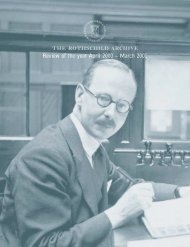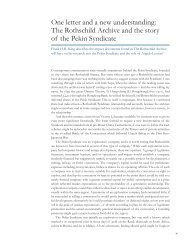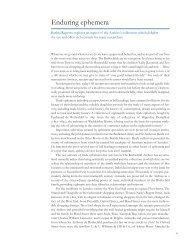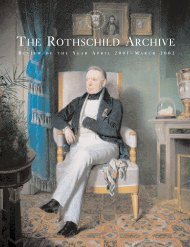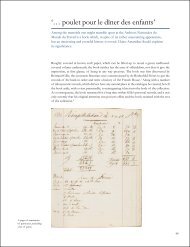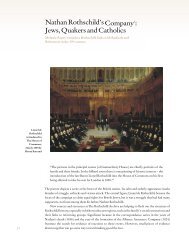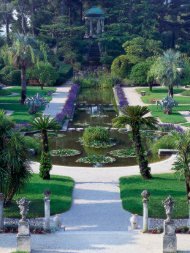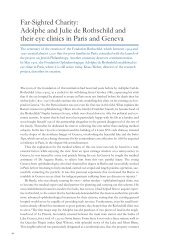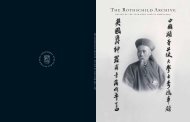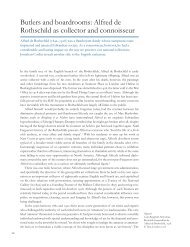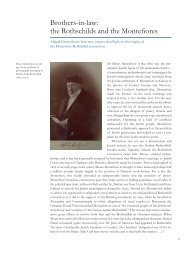66900 Rothschild Archive - The Rothschild Archive.
66900 Rothschild Archive - The Rothschild Archive.
66900 Rothschild Archive - The Rothschild Archive.
Create successful ePaper yourself
Turn your PDF publications into a flip-book with our unique Google optimized e-Paper software.
Gainsborough was if anything a throwback to the taste of Sir Robert Peel and other connoisseurs<br />
of fifty years before. In 1916, when the Gallery seriously considered selling off some of<br />
Peel’s collection of Dutch paintings (acquired in 1871), Alfred protested strongly that they were<br />
‘gems’.⁷ To that extent his taste was ‘unreconstructed’, not least in preferring Guardis and<br />
Seicento works to the earlier Quattrocento Italians rediscovered earlier in the century. His purchase<br />
of a highly questionable Titian belonging to the 2nd Lord Methuen for £3,500 (Toilet of Venus,<br />
now Courtauld Gallery) suggests that his eye for Italians was less than acute.<br />
In buying eighteenth-century French art Alfred was more in tune with his times, the<br />
Goncourt Brothers having attracted renewed attention to this school. His interest earned him<br />
the honour of being appointed one of the founding Trustees of the Wallace Collection by Lady<br />
Wallace, a duty he clearly took very seriously. Alfred sat on the official committee which in 1897<br />
considered the question of where and how the Wallace Bequest should be housed, opposing<br />
plans to move the collection to a new annexe to be built on the Hampton Site contiguous to<br />
the National Gallery. Alfred saw the Wallace paintings, furnishings and armour as a Gesamtkunstwerk,<br />
fearing that a more scholarly arrangement would prevent visitors from admiring the<br />
taste with which Sir Richard Wallace had arranged his possessions. At the same time he insisted<br />
on the installation of electric lighting, donating several electric torchieres. Such illumination had<br />
been laid on at Halton, but was almost unheard of in public galleries. He also had the gilding<br />
on the furniture and frames renewed, something which struck many as vulgar.⁸<br />
An enthusiasm for paintings of attractive women clearly played a significant role in guiding<br />
Alfred’s taste, as seen in the coquettish Reynolds portrait of Miss Angelo (1770, acquired by 1884)<br />
and in the sultry portraits of pubescent girls by Greuze. Alfred owned several examples of<br />
these, unsuccessfully attempting to acquire yet one more from Sir Richard Wallace in 1875,<br />
when he offered to swap it for some Sèvres porcelain.⁹ As a Trustee he would infuriate a succession<br />
of Gallery Directors by opposing the purchase of works depicting women he thought<br />
ugly or plain, even when painted by artists of which he approved, such as Bronzino.<br />
Collecting for Alfred was primarily about furnishing the walls of his residences, something<br />
that might lead us to belittle his taste. In fact, the paintings were the focus of the spaces he created<br />
for himself and his guests, as is shown by the way he named rooms after the painters whose<br />
works hung there, or even after a specific painting, as seen in the ‘Bampfylde Room’ at Halton,<br />
where the eponymous portrait (1776) by Reynolds hung. ₁ ⁰ <strong>The</strong>se paintings were the backdrop<br />
to the opulent entertainments Alfred put on for his guests at Halton. As Alfred’s guest book<br />
attests, ₁₁ these hailed not only from the political and aristocratic elite, but also from the stage,<br />
Roughing it at Halton, Sir<br />
Max Beerbohm’s view of<br />
Alfred de <strong>Rothschild</strong>.<br />
Far right<br />
Alfred de <strong>Rothschild</strong>,<br />
Julius Luz.<br />
29



